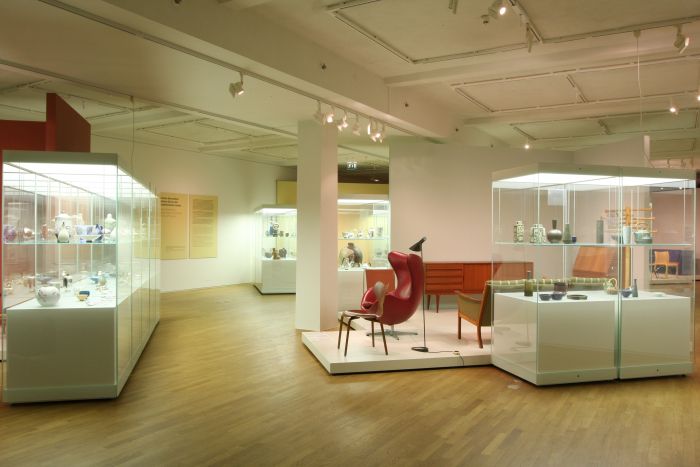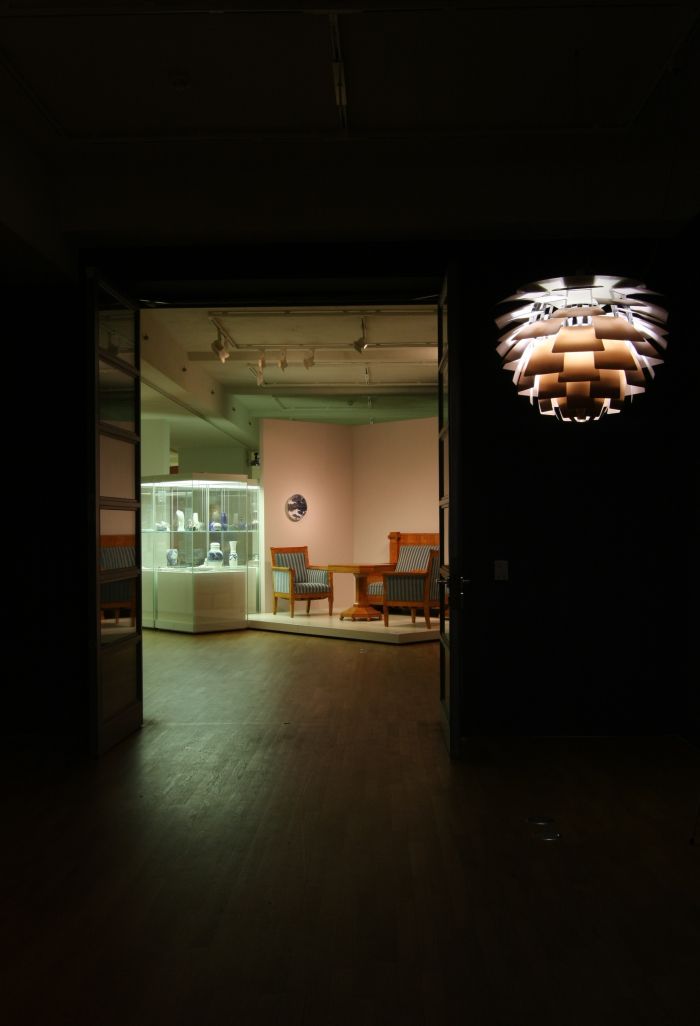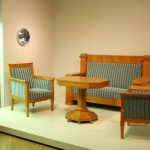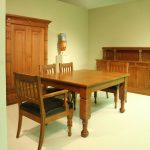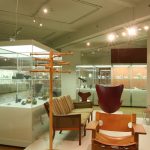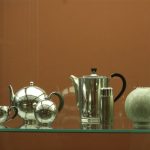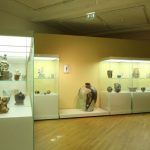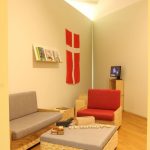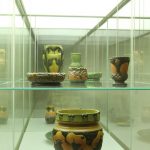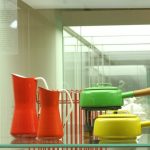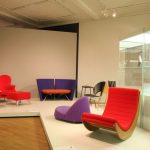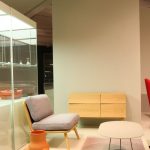Made in Denmark. Design since 1900 @ Grassi Museum of Applied Arts Leipzig
Rely too heavily on popular representations of design from Denmark and one could come to the conclusion that Danes only started designing objects in the late 1940s, so often is one presented with Danish design books, exhibitions and newspaper/magazine/blog articles that begin, self-evidently, post-War.
With their exhibition Made in Denmark. Design since 1900, the Grassi Museum of Applied Arts Leipzig demonstrate that design in Denmark does have a pre-war, and pre-design, history.
Ahead of the exhibition’s opening the Grassi Museum Leipzig’s Director Dr Olaf Thormann posed the, rhetorical, question, why such an comprehensive exhibition of Danish design should be taking place in Leipzig? A question which had already occurred to us, Leipzig isn’t exactly known for its close relationship with Denmark, wasn’t even hanseatic, although its citizens’ would have no doubt feasted on the legendary medieval Danish herring. But why Danish design in Leipzig?
The answer lies in the history of the Grassi museum, or perhaps better put in the (hi)story of its collection. According to Dr Thormann the museum’s founding collection from 1874 contained examples of Danish ceramics acquired at the 1873 Vienna world’s Fair, the museum’s first Art Nouveau exhibition in 1897 was of Danish luster faiene from the manufacturer Kähler, while in 1927 Denmark occupied two rooms at the Grassi Museum’s celebrated European Decorative Arts exhibition, and in the wake Danish creatives were regular participants at the annual Grassimesse. Each event and each encounter allowing new opportunities for further purchases and thus allowing the Grassi to develop not only a wide-ranging Danish collection, but close links to Denmark. Then came the war, the DDR and an enforced reduction in the encounters and opportunities; however, since unification, and for all in the past few years, the museum have re-intensified their relationship with Denmark and currently boast a collection of some 950 objects. And because collections exist to be used and not merely stored and dusted, the Grassi Museum is presenting some 320 of its objects to help elucidate the story of Danish creativity since 1900.
Which seems only logical, and sensible, as the institution has accompanied it on that journey. Were, if you will, early adopters of Danish design. Before 1945.
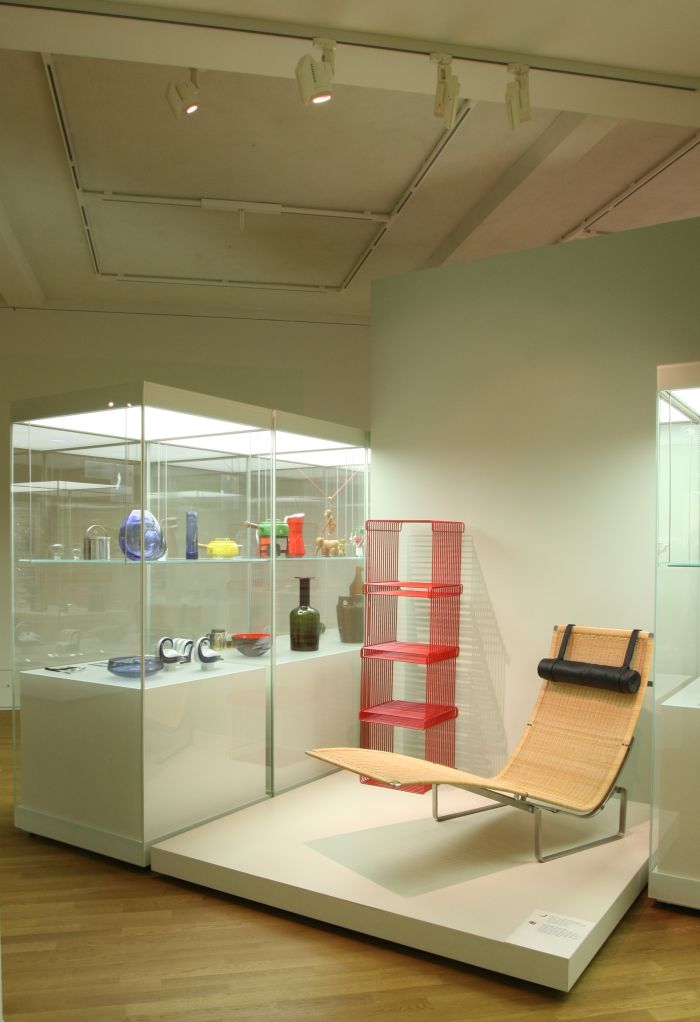
PK24 chaise longue by Poul Kjaerholm & Wire Shelf by Verner Panton, as seen at Made in Denmark. Design since 1900, Grassi Museum of Applied Arts Leipzig
Divided into six sections, technically seven, but well get to that later, Made in Denmark takes the visitor on a chronological tour through 120 years of Danish creativity; despite the fairly unequivocal “1900” in the exhibition title the oldest objects are from the late 19th century. The youngest are from 2018.
Given the fact that the Grassi Museum of Applied Arts Leipzig is an applied art museum and principally collects applied art, there is a lot of applied art on show: ceramics, silver, stoneware, tin, glass, earthenware, cutlery, et al.
And yes, that means a lot of objects in glass vitrines, and no that’s never a pleasing concept, is however all to often unavoidable, and a challenge the Grassi have very neatly resolved, presenting as they do an intelligent exhibition format that keeps the vitrines sparsely populated, through presenting enough objects to allow for a coherent and informative narrative, but without overwhelming or overloading the visitor.
In addition Made in Denmark presents examples of furniture, lighting and toy design, and yes Abe by Kay Bojesen, it being the law that all exhibitions on Danish deign must include the Abe. Which isn’t a complaint, far from it, we’re always glad to see his/her satisfyingly satisfied simian smirk, and in Leipzig he/she has a few friends with whom to share his/her glass cage.
The objects are ably supported by concise, bi-lingual English/German wall texts which help set the scene of the respective chapters, and also brief biographies of some of the key protagonists, a very important part of the exhibition concept as most of the names, certainly in the first half of the exhibition, will be unfamiliar to most visitors. And that despite their importance for the development of design in Denmark. But who had the misfortune to have been born in the dark ages. Before 1945.
Although one is greeted at the door of the exhibition by Paul Hennigson’s PH Artichoke Lamp, one of the real joys of the exhibition is that it isn’t about those examples of “Danish Design” you may be familiar with, indeed one has at times the feeling it is actively shying away from such, something that the absence of Verner Panton’s ubiquitous and eponymous plastic cantilever chair tends to underscore. And we know the Grassi Museum have one. Made in Denmark instead presents a more variegated and differentiated view of Danish creativity.
The first chapter is devoted to the, relatively, unknown world of Danish Art Nouveau. Popularly known under the term Skønvirke, a name which, and as with Jugendstil, was borrowed from a magazine that promoted reformist artists of the period, the motivations of Danish Art Nouveau artists were very much on a parr with the likes of Mackintosh, Behrens, Hoffmann, van de Velde et al, or as a wall quote from Johan Rohde notes “My endeavour has been to subordinate decoration to the architectonic and to give the material and the treatment of it a decisive influence on reality”
However, as the Danish designer and author Thomas Dickson told us Art Nouveau “had its own interpretation and form in Denmark”, and when one views the objects from the first years of 20th century one can get a feeling for what he means. While there are, for example, floral and natural motives, they are, generally, presented much more naturalistic than the typically figurative representations that were being produced at the same time in Darmstadt, Vienna or Glasgow, while the objects themselves tend to be more closely related to classical genres and format. Not in a neoclassical way, they are very much new interpretations, a new approach and based on new understandings. Have however, and much as the furniture of a Edward J Wormley, retained something of the aura of periods past.
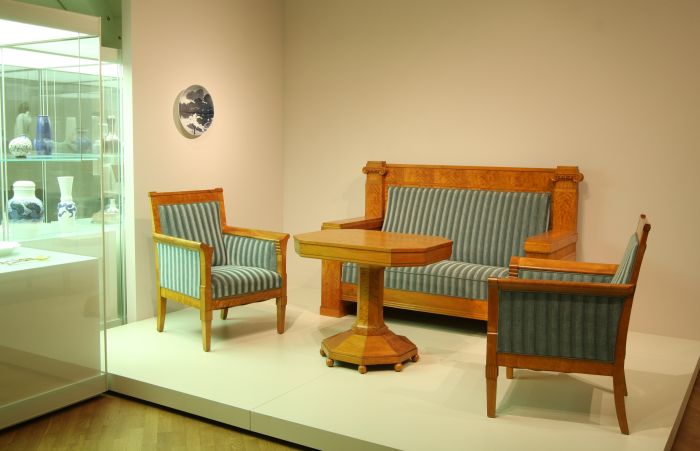
Salon Ensemble by Johan Rohde (ca. 1900), as seen at Made in Denmark. Design since 1900, Grassi Museum of Applied Arts Leipzig
Similarly the two Art Nouveau furniture suites presented cut a much more classical figure than one would have, necessarily, expected to find elsewhere. While we’d never claim that one can surmise a design period in a few objects, and accepting that we are by necessity generalising to the point of falsehood; however, when one compares the works by Thorvald Bindesbøll and Johan Rohde from 1905 and 1900 respectively, to works created around the same time by the likes of Mackintosh, Behrens or Hoffmann, while there is a formal reduction, the Danish works aren’t showing the same level of material or constructive reduction. The Danish works still seem to be keen to make their presence felt, don’t have the visual lightness, still want to be considered as their predecessors.
From Art Nouveau the exhibition follows the familiar path taken by European design over art deco, functionalism onto post-War, post-functionalist positions, whereby, and as with Art Nouveau, this is very much a Danish progression, a much more reserved, moderate, understated progression, one where the creatives are feelingly their way more tentatively forward than their contemporaries, and one represented by works from designers, artists and architects as varied as Alma Agnethe Jørgensen, Ole Wanscher, Kaare Klint, Nanna Ditzel, Jens Harald Quistgaard or Arne Jacobsen. Having explained the path taken Made in Denmark ends with contemporary projects: contemporary Danish ceramics are given a section of their own which discusses contemporary position in Danish ceramics, while contemporary furniture and accessories is represented by works from the likes of Louis Campbell, Cecilie Manz or Kasper Salto. The final section, the seventh of the exhibition’s six, is given over to examples of contemporary Danish jewellery design from the private Schwandt collection, a nice extension of the exhibition bringing in as it does a further genre and one which effortlessly compliments the rest of the exhibition.
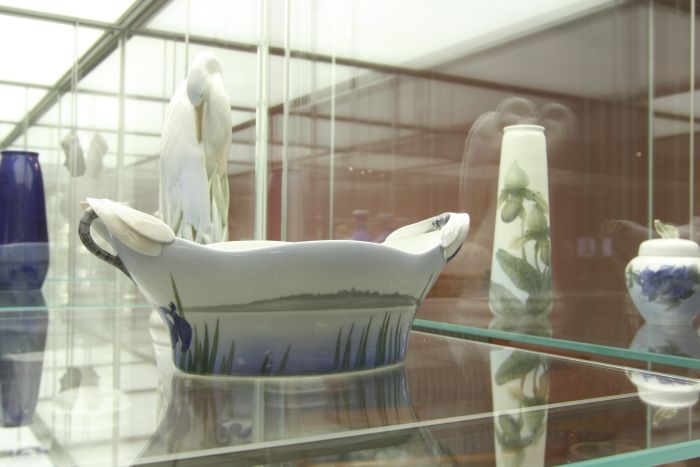
Bowl by Theodor Madsen (1901), as seen at Made in Denmark. Design since 1900, Grassi Museum of Applied Arts Leipzig
By necessity, the longer the time period an exhibition covers the less depth it can have, and so is it with Made in Denmark. While very neatly and succinctly explaining the evolution and development of design in Denmark, there is (next to) no space for discussing the cultural, social, technological, political and economic realities of the century and a fifth covered by the exhibition. Yet as with all creative genres, design is inextricably linked with such changes.
And while we did admittedly miss such a discussion, we also understand that doing such would not only have meant increasing the size of the exhibition by several fold, not just in terms of wall texts but also through the need for objects from areas currently not included such as transportation, electronics, printing, graphics, typography, etc, but would have been a very, very different exhibition.
With Made in Denmark the Grassi have produced an exhibition which seeks less the why and wherefore and much more the what and how, an exhibition which tracks the evolution of design in Denmark in context of objects, materials, processes and in terms of those protagonists who over the decades have played decisive roles in advancing understandings of and approaches to art, applied arts, crafts and design in Denmark. And does that most eloquently.
A well paced, accessible, informative and entertaining presentation Made in Denmark is not a only a fulsome representation of Danish creativity, but a well balanced, well judged explanation of how design in Denmark developed in the course of the 20th century; how design in Denmark, while following familiar paths, did so with a light yet identifiable, Danish accent; how the reduction many associate with Danish design is in many ways more a reservation, moderation, material necessity; that Danish design can be confrontational, abrupt, playful, abstract and therefore provides for a very welcome, very honest review of Danish design. And for all a confirmation that Danish designers were very active before 1945.
Made in Denmark. Design since 1900 runs at the Grassi Museum of Applied Arts, Johannisplatz 5-11, 04103 Leipzig until Monday October 7th.
Full details, including information on the accompanying fringe programme can be found at www.grassimuseum.de
- Salon Ensemble by Johan Rohde, as seen at Made in Denmark. Design since 1900, Grassi Museum of Applied Arts Leipzig
- Dining Room Ensemble by Thorvald Bindesbøll (1906), as seen at Made in Denmark. Design since 1900, Grassi Museum of Applied Arts Leipzig
- Objecst by Borge Mogensen, Ole Wanscher & Nanna Ditzel, as een at Made in Denmark. Design since 1900, Grassi Museum of Applied Arts Leipzig
- Made in Denmark. Design since 1900 @ Grassi Museum of Applied Arts Leipzig
- Made in Denmark. Design since 1900 @ Grassi Museum of Applied Arts Leipzig
- (Danish) Children’s Play Area, as seen at Made in Denmark. Design since 1900, Grassi Museum of Applied Arts Leipzig
- Eartheware by Thorvald Bindesbøll, as seen at Made in Denmark. Design since 1900, Grassi Museum of Applied Arts Leipzig
- Made in Denmark. Design since 1900 @ Grassi Museum of Applied Arts Leipzig
- Objects by Jens Harald Quistgaard for Dansk Designs, as seen at Made in Denmark. Design since 1900, Grassi Museum of Applied Arts Leipzig
- Made in Denmark. Design since 1900 @ Grassi Museum of Applied Arts Leipzig
- Silver work from ca 1900-1910, as seen at Made in Denmark. Design since 1900, Grassi Museum of Applied Arts Leipzig
- Made in Denmark. Design since 1900 @ Grassi Museum of Applied Arts Leipzig
Tagged with: Denmark, Grassi Museum for Applied Arts Leipzig, Leipzig, Made in Denmark. Design since 1900
